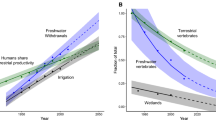Abstract
Historically management of human use of ecosystems has been based around engineering and chemical approaches and through the construction of treatment facilities, effluent controls and setting chemical concentrations, both at end of pipe and in the aquatic environment. However, the general continued degradation of many ecosystems shows these approaches alone are insufficient. In the Laurentian Great Lakes the Great Lakes Water Quality Agreement was first signed in 1972 and ratified in 1978 and in 1987 tacitly acknowledged the problems with a chemical only approach by requiring the development of ecosystem objectives in the 1978 agreement. Furthermore, the agreement specifically identified numerical ecosystem objectives in the 1987 agreement. The evolution of ecosystem objectives in the Great Lakes has expanded from the strictly numerical objectives such as production of lake trout and abundance of the amphipod Pontoporeia hoyi. More recent developments in ecosystem objectives have been the inclusion of indicators for wildlife, habitat, human health and stewardship.
Similar content being viewed by others
References
Burns N. M., 1985. Erie, the Lake that Survived. Rowman & Allanheld, New Jersey, 320 pp.
Great Lakes Research Advisory Board, 1978. The Ecosystem Approach. Special Report of the Research Advisory Board to IJC, Windsor, Ont. 49 pp.
Loftus K. H. & H. A. Regier, 1972. Introduction to the proceedings of the 1971 symposium on salmonid communities in obligotrophic lakes. J. Fish. Res. Board Can. 29: 613–616.
Ryder R. A. & C. J. Edwards, 1985. A Conceptual Approach for the Application of Biological Indicators of Ecosystem Quality in the Great Lakes Basin. Internat. Joint Comm., Windsor, Ont. 169 pp.
Ryder R. A. & C. J. Edwards, 1990. Biological Surrogates of Mesotrophic Ecosystem Health in the Laurentian Great Lakes. Internat. Joint Comm., Windsor, Ont. 69 pp.
Reynoldson T. B., D. W. Schloesser & B. A. Manny, 1989. Development of a benthic invertebrate objective for mesotrophic Great Lakes waters. J. Great Lakes Res. 15: 669–686.
Author information
Authors and Affiliations
Additional information
Prepared as a discussion paper presented to the United Nations Economic Commission for Europe's seminar on an Ecosystems Approach to Water Management (May 27–31, 1991).
Rights and permissions
About this article
Cite this article
Reynoldson, T.B. The development of ecosystem objectives for the Laurentian Great Lakes. J Aquat Ecosyst Stress Recov 2, 81–85 (1993). https://doi.org/10.1007/BF00044720
Issue Date:
DOI: https://doi.org/10.1007/BF00044720




